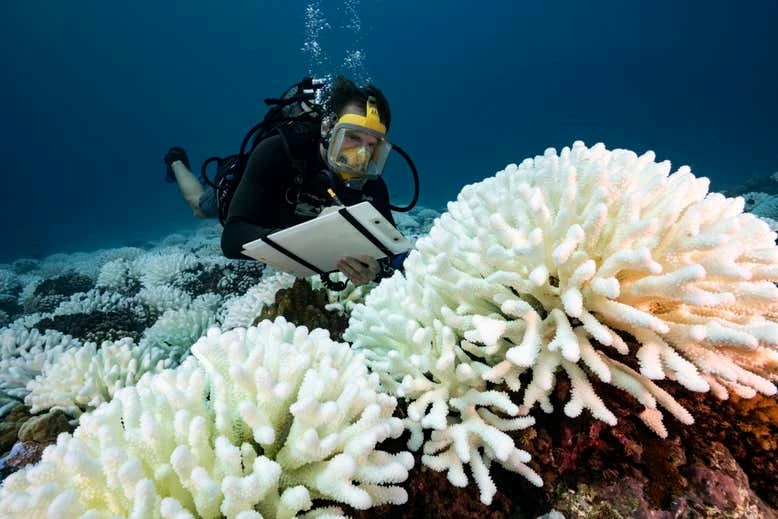We are on track to reach six climate tipping points by 2030
Some screen time before bedtime may, in fact, be safe for sleep / Martian rock-metal composite shows potential of 3D printing on Mars
The collapse of the West Antarctic ice sheet and the abrupt thawing of permafrost are among six climate tipping points likely to be reached if global warming exceeds 1.5°C, the Paris Agreement's 2015 target.
In 2008, scientists identified nine tipping points in the planet's climate system: irreversible and self-perpetuating processes, such as ice melt, that could accelerate climate change. Now, David Armstrong McKay and his colleagues at the University of Exeter in the United Kingdom have completed the first comprehensive assessment of these potential shifts and the amount of global warming required to trigger them.

The die-off of coral reefs is a tipping point that could be triggered after 1.5°C of warming.
Previously, it was believed that the majority of tipping points would occur when the global average temperature rose approximately 3°C above that of pre-industrial times. However, a new study found that some could occur at significantly lower temperatures.
Additionally, the number of tipping points has grown to sixteen. Changes in the Labrador Sea, part of the North Atlantic, which could cool Europe, have been added, while others, such as the loss of Arctic sea ice, have been removed because they are no longer considered to have a tipping point dynamic.
Since the industrial revolution, the world has already warmed by 1,1°C; at this point, the likelihood of some tipping points occurring is minimal. However, at 1.5°C, six of them become probable, including the Greenland ice sheet's collapse and the death of coral reefs. Four more are possible, ranging from the abrupt loss of ice in the Barents Sea to the collapse of the vital Atlantic Ocean conveyor belt, a large system of currents that transports warmer, tropical water northward, and whose disruption could result in more extreme heat and cold on both sides of the ocean.

Greenland ice sheet's collapse could result in more extreme heat and cold.
“This provides really strong scientific support for rapid cutting of emissions in line with the 1.5°C goal,” says Armstrong McKay. “But the closer you get to 2°C, the more likely some of these tipping points get. Where we’re heading at the moment is something like 2.6°C — that’s definitely going to hit lots of tipping points.”
The Intergovernmental Panel on Climate Change (IPCC) report from 2012 highlighted the risk of tipping points but did not specify the temperatures at which each could be triggered. Armstrong McKay and colleagues combed through scientific literature and solicited estimates from experts regarding the amount of warming necessary to trigger the tipping points.
Since 2008, temperature thresholds have decreased due to a subsequent research explosion. Improving modeling, particularly of ice sheets, has been crucial. Thousands-of-years-old air bubbles captured in ice cores and other palaeoclimate records have taught us how ice sheets responded when the world was 1.5°C hotter in the past. In recent years, scientists have also observed the onset of Greenland ice sheet destabilization and Atlantic conveyor belt weakening.
“The science of climate change has advanced hugely in the intervening 14 years and [the study authors] now provide a reassessment based on the latest science. And it is not good news,” says Mark Maslin at University College London, who wasn’t involved in the research.
The tipping points can now be anticipated much sooner than previously believed. At around 1.5°C of warming, which the IPCC predicts could occur in the 2030s, many are deemed probable or conceivable. “It’s all a lot closer than we were feeling like they were before,” says Armstrong McKay.
A glimmer of hope is that the most imminent tipping points, such as the collapse of the West Antarctic ice sheet — which some scientists believe has already begun — will not have a massive feedback effect that results in runaway warming. Armstrong McKay says: “Some people will look at this and go, ‘well, if we’re going to hit tipping points at 1.5°C, then it’s game over’. But we’re saying they would lock in some really unpleasant impacts for a very long time, but they don’t cause runaway global warming.”
Nonetheless, he asserts that societies must act immediately to prevent tipping points from being reached, in order to prevent consequences such as an enormous rise in sea level that could result from the loss of Antarctic and Greenland ice sheets over millennia or centuries. “We’d be locking in future generations to an extremely different planet with 10 metres or more sea level rise. It would completely reshape the coasts of every continent,” says Armstrong McKay.
As his team notes, most of the systems they assess “contribute significantly to human welfare”. An abrupt thaw of permafrost, according to Maslin, would be "devastating for human society and should be avoided at all costs."
The new research does not examine how the tipping points may interact with one another. Some may exacerbate the effects of others, while others will have a cooling effect that counteracts the warming effect of others.
Armstrong McKay states that the transformation of the Amazon from rainforest to savannah, which would increase carbon dioxide emissions, is the tipping point that most concerns him. This is not predicted unless warming exceeds 2°C, but this does not account for the deforestation there.
The collapse of ice sheets is more of a distant issue that can seem abstract, whereas the collapse of the Amazon could occur during our lifetimes, with indications that the transition has already begun in some areas. “That’s the one that you would actually see happening in real time,” he says.
Journal reference: Science, DOI: 10.1126/science.abn7950
End of content
Không có tin nào tiếp theo
